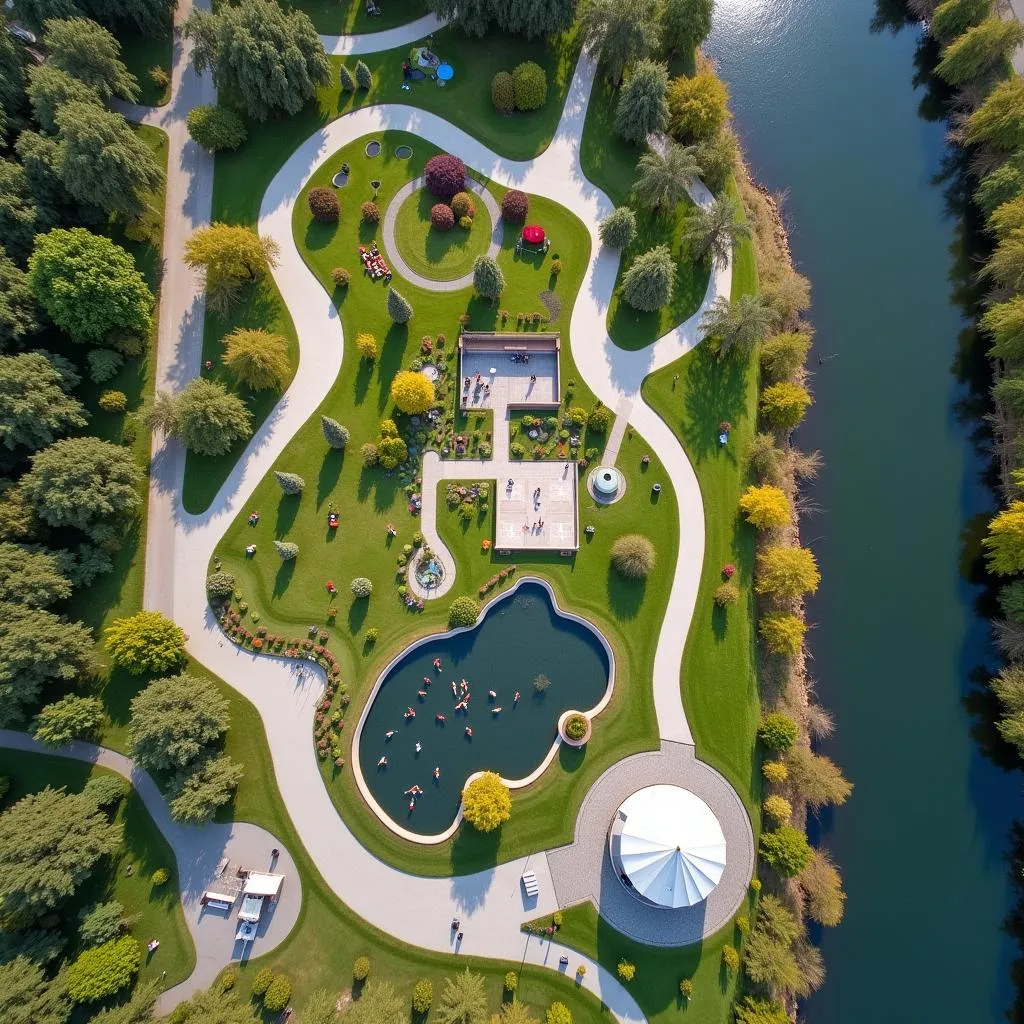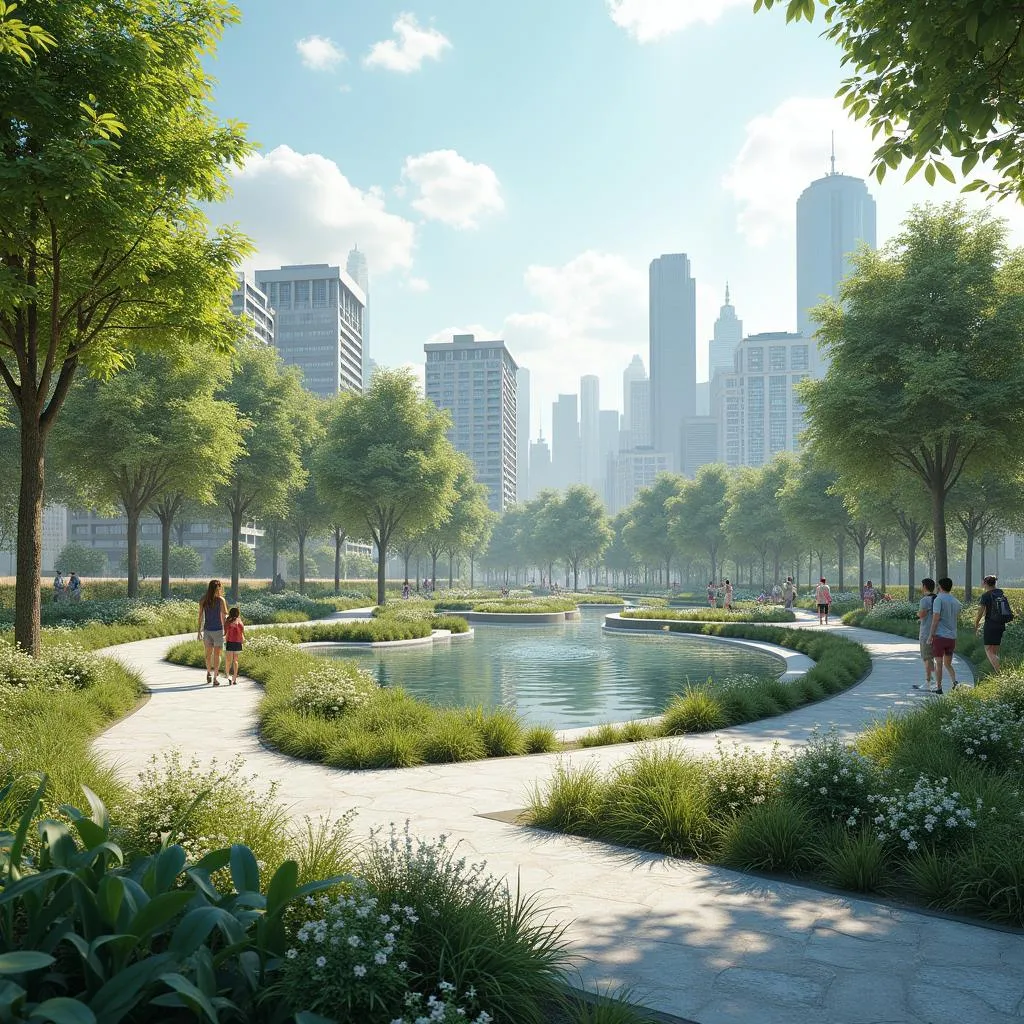Public parks are common topics in IELTS Speaking tests, often appearing in Part 1 or Part 2. This article will guide you through answering questions about a memorable public park, providing sample answers and strategies to help you achieve a high score.
Table Of Contents
Part 1: Introduction and Interview
In Part 1, you may encounter questions like:
- Do you often visit public parks?
- What do you usually do when you go to a park?
- Are there many public parks in your city?
Let’s focus on the first question:
Examiner: Do you often visit public parks?
Band 6-7 Answer:
Yes, I do. I try to visit the park near my house at least once a week. It’s a nice place to relax and get some fresh air.
Band 8-9 Answer:
Absolutely. I make it a point to frequent the local park in my neighborhood at least twice a week. It’s not just a place for relaxation, but also serves as my go-to spot for outdoor exercise and connecting with nature. The park offers a welcome respite from the hustle and bustle of city life, allowing me to recharge and clear my mind.
Part 2: Long Turn
Cue Card:
Describe a memorable public park in your area. You should say:
- Where it is located
- What features it has
- What activities people do there
- And explain why it is memorable to you
Band 6-7 Answer:
The park I want to talk about is called Central Park, located in the heart of my city. It’s quite big and has a lot of green space. There are several playgrounds for children, a large pond, and many walking paths.
People go there to do various activities. Many jog or walk their dogs on the paths. Families often have picnics on the grass, and children play on the playground equipment. In summer, some people even go boating on the pond.
This park is memorable to me because I’ve been going there since I was a child. I have many happy memories of playing there with my friends and family. Now, as an adult, I still enjoy visiting the park to relax and enjoy nature.
Band 8-9 Answer:
I’d like to describe a truly remarkable public park in my area, known as Riverside Gardens. This expansive green oasis is strategically situated along the banks of the main river that runs through our city, making it easily accessible to residents and visitors alike.
What sets this park apart are its diverse and well-maintained features. The park boasts an intricate network of winding paths, perfect for leisurely strolls or invigorating jogs. A standout attraction is the meticulously designed Japanese garden, complete with a serene koi pond and an elegant wooden bridge. For the more active visitors, there’s a state-of-the-art outdoor gym and several multi-purpose sports courts.
The park serves as a hub for a wide array of activities, catering to people of all ages and interests. Fitness enthusiasts can often be seen partaking in group yoga sessions or utilizing the outdoor gym equipment. Families frequently gather for picnics in the designated areas, while art lovers are drawn to the regular outdoor exhibitions and performances held in the park’s amphitheater. During the warmer months, the park comes alive with various cultural festivals and open-air movie screenings.
What makes Riverside Gardens truly memorable for me is its ability to transform with the seasons, offering a unique experience each time I visit. The vibrant explosion of cherry blossoms in spring, the lush green canopy in summer, the breathtaking foliage in autumn, and the serene snow-covered landscape in winter all create lasting impressions. Moreover, this park has been the backdrop for many significant moments in my life, from first dates to family celebrations, making it an integral part of my personal history and the community’s collective memory.
 Aerial view of Riverside Gardens Park
Aerial view of Riverside Gardens Park
Follow-up questions:
- How often do you visit this park?
- Do you think public parks are important for cities?
Band 6-7 Answer (Question 1):
I try to visit Riverside Gardens at least once a month. It’s a nice place to relax and enjoy nature, especially on weekends when I have more free time.
Band 8-9 Answer (Question 1):
I make it a point to frequent Riverside Gardens on a regular basis, typically two to three times a week. It has become an integral part of my routine, serving as both a tranquil retreat for relaxation and a convenient venue for my fitness regimen. The park’s ever-changing scenery and diverse amenities ensure that each visit offers a fresh and invigorating experience.
Band 6-7 Answer (Question 2):
Yes, I think public parks are very important for cities. They provide green spaces where people can relax and exercise. Parks also help to reduce pollution and make cities more beautiful.
Band 8-9 Answer (Question 2):
Absolutely, I firmly believe that public parks play a crucial role in urban environments. They serve as vital green lungs for cities, helping to mitigate air pollution and combat the urban heat island effect. Moreover, parks foster community cohesion by providing spaces for social interaction and cultural events. They also contribute significantly to public health by offering accessible areas for physical activity and stress relief. From an ecological standpoint, urban parks are essential habitats for local flora and fauna, promoting biodiversity within city limits. In essence, public parks are indispensable assets that enhance the quality of life for city dwellers in numerous ways.
Part 3: Two-way Discussion
Examiner: How do you think public parks in cities might change in the future?
Band 6-7 Answer:
I think public parks in the future might have more technology. They might have better playgrounds and exercise equipment. Parks might also focus more on being environmentally friendly, with more native plants and better ways to save water.
Band 8-9 Answer:
I envision that public parks of the future will likely undergo significant transformations to adapt to changing urban needs and technological advancements. We may see the integration of smart technology, such as interactive information kiosks and Wi-Fi-enabled areas, to enhance visitor experiences and provide real-time data on park usage and environmental conditions.
Sustainability will likely take center stage, with parks incorporating innovative green infrastructure like rain gardens and bioswales to manage stormwater runoff more effectively. There might also be a greater emphasis on urban agriculture, with community gardens and edible landscapes becoming more prevalent.
To address climate change, future parks may feature more climate-resilient designs, including drought-resistant plantings and flood-mitigation measures. Additionally, we might see an increase in multifunctional spaces that can adapt to various uses, from outdoor classrooms to pop-up markets, reflecting the evolving needs of urban communities.
Lastly, I believe there will be a stronger focus on inclusivity and accessibility, with parks designed to cater to people of all ages and abilities, potentially incorporating sensory gardens for individuals with disabilities and intergenerational play areas to foster community connections.
 Futuristic concept of an urban public park
Futuristic concept of an urban public park
Key Vocabulary and Phrases for High Scores
-
Expansive green oasis /ɪkˈspæn.sɪv griːn ˈəʊ.eɪ.sɪs/ (noun phrase): A large area of greenery in an urban setting, providing a peaceful retreat.
Example: “The new park is an expansive green oasis in the heart of our concrete jungle.” -
Meticulously designed /məˈtɪk.jə.ləs.li dɪˈzaɪnd/ (adjective phrase): Carefully and precisely planned and created.
Example: “The Japanese garden was meticulously designed to create a sense of tranquility.” -
To come alive /kʌm əˈlaɪv/ (phrasal verb): To become more active or exciting.
Example: “The park comes alive with festivals and events during the summer months.” -
Backdrop /ˈbæk.drɒp/ (noun): The setting or scenery behind something.
Example: “The park has been the backdrop for many important events in my life.” -
To foster /ˈfɒs.tər/ (verb): To encourage or promote the development of something.
Example: “Public parks foster a sense of community among city residents.” -
To mitigate /ˈmɪt.ɪ.ɡeɪt/ (verb): To make less severe, serious, or painful.
Example: “Urban green spaces help to mitigate the effects of air pollution in cities.” -
Indispensable /ˌɪn.dɪˈspen.sə.bəl/ (adjective): Absolutely necessary or essential.
Example: “Parks are indispensable assets for maintaining quality of life in urban areas.” -
To undergo transformations /ˌʌn.dəˈɡəʊ træns.fəˈmeɪ.ʃəns/ (verb phrase): To experience significant changes.
Example: “Public spaces are undergoing transformations to meet the evolving needs of city dwellers.”
Examiner’s Advice
To achieve a high score in the IELTS Speaking test when describing a public park or any other topic:
-
Use a wide range of vocabulary: Incorporate advanced and topic-specific words naturally in your responses.
-
Vary your grammatical structures: Use a mix of simple and complex sentences, and demonstrate your ability to use different tenses accurately.
-
Provide detailed responses: Elaborate on your answers with examples and personal experiences to showcase your English proficiency.
-
Maintain fluency: Practice speaking at length on various topics to improve your ability to speak smoothly and confidently.
-
Show critical thinking: In Part 3, demonstrate your ability to analyze and discuss abstract ideas related to the topic.
-
Stay relevant: Always address the question asked and stay on topic throughout your response.
-
Use appropriate pronunciation and intonation: Clear pronunciation and natural intonation contribute significantly to your overall score.
Remember, regular practice is key to improving your speaking skills. Consider recording yourself or practicing with a study partner to identify areas for improvement.
Describe a time when you went on a nature hike to further enhance your ability to discuss outdoor experiences. Additionally, you might find it helpful to describe a place in nature where you enjoy going alone to practice expressing personal preferences and experiences in natural settings.
By applying these strategies and continuously expanding your vocabulary and range of expression, you’ll be well-prepared to excel in the IELTS Speaking test, particularly when discussing topics related to public spaces and the environment.



